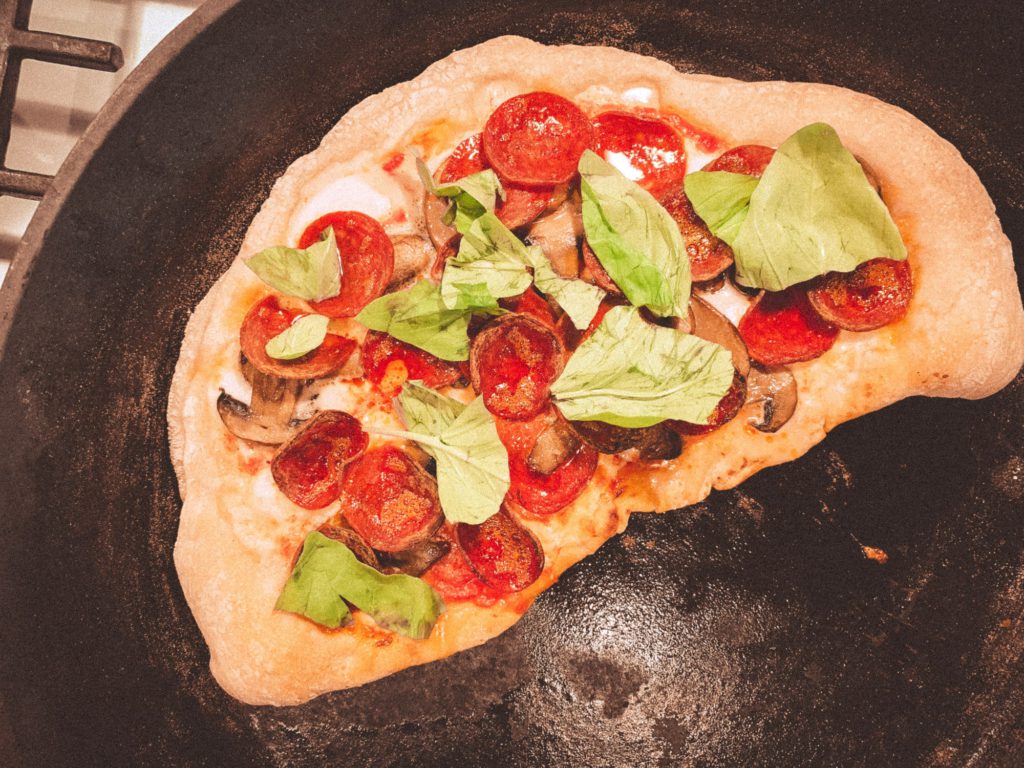Neapolitan pizza* has been around for a long time, loads of people have written about it, and even more have strong opinions on it. So, I won’t waste your time trying to tell you what it is or give a history. Others, who know way more about the style than I do, have already done that. What I want to share here are the best recipes I’ve found so far and a few tips on how to get good results in your home oven. Unlike some of the pizza styles I write about, I’ve had Neapolitan pizza several times, with my current favorite coming from Pupatella, in Arlington, VA.
*When I use "Neapolitan pizza" in this and other posts, I'm not referring to pizza that adheres to the Associazione Verace Pizza Napoletana's (AVPN) regulations. Making pizza that meets the AVPN's regulations isn't possible in a home oven — among other challenges the regulations require the oven to reach a temperature over 900° (485° C) and the pizza can be baked for a maximum of 90 seconds.
Tips for Making Neapolitan Pizza in a Home Oven
For a while, I thought that getting anything close to Neapolitan pizza required an oven capable of reaching 800 degrees plus. But, I’ve recently discovered that you actually can get something reasonably close to Neapolitan pizza in your home oven, without any special equipment.**
**I've heard pizza steels are great for Neapolitan pizzas and have one on order as of this writing. I'll share more when I get it, but I don't think it's essential to have one. I've also heard great things from people who use Ooni ovens. I hope to get an Ooni, if I ever move somewhere I can have one, and I'm sure they produce excellent results. But, again, I don't think you need one to make solid Neapolitan pizza.
When I first started making Neapolitan pizzas, I had a pizza stone. My results with it were sub par, and I found sliding the pizza onto it without the toppings all ending up on one side or the dough folding over itself, nearly impossible. (Granted, I was sliding it from the back of a sheet pan, not a peel.) Thankfully, I broke the stone quickly, which forced me to find other, better tools.
The stone break came early in my pizza making career, and, not wanting to sink money into what I thought might be a fleeting hobby, I didn’t want to buy anything and also didn’t want to wait for something new to arrive. So, I looked around my kitchen for what I could use and realized my massive cast iron skillet had potential. Through some trial and error, I came up with a technique where I heated the skillet in the oven at max heat for at least 30 minutes. Then, I’d carefully pull out the insanely hot skillet, gently drop in a pre-stretched pizza, and start topping it. (Initially, I continued with sliding a pre-topped pizza off the back of a sheet pan but that continued to lead to misshapen pizzas.)

Putting in the untopped dough solved the transfer problems I had and gave the crust a head start on cooking, allowing the bottom to start browning while I topped the pizza. Once I had the toppings on, I’d pop the pizza back in the oven and cook until the toppings were done.
I thought I was a genius to have come up with this method. Then I did some research and realized someone else had already thought of and improved on it. Now, I follow Kenji’s method, except I still pre-heat the pan in my oven to help with even heat distribution. I also often use my oven at max heat instead of my unreliable broiler.
In addition to the modifications listed here, you need to choose the right recipe. Ideally, one with more water (a higher hydration), than an authentic Neapolitan pizza dough. This is because the home oven’s longer cooking time means more water will evaporate during cooking, requiring a wetter dough to avoid a dry crust. There are other modifications that some suggest as well.
Ingredients for Neapolitan Pizza
The great thing about pizza is how much creativity and freedom it gives. Some might disagree, but I think that applies to Neapolitan pizza as well. However, there are a few ingredients that I think lead to better outcomes.
The way fresh mozzarella melts and forms a creamy sauce where it blends with the tomato sauce, combined with its simple and delicate flavor, make it hard to beat on Neapolitan pizzas. I get good results with the standard ciliegine fresh mozzarella balls* that come in a plastic container filled with water and cheese balls. But, if you can afford it, Mozzarella di Bufala is even better, mainly because it has a richer and smoother texture.
*Ciliegine refers to the size of the mozzarella ball. They are roughly the size of a cherry. I like to break them up a little when adding them to pizza. Bocconcini are larger and ovolini even bigger, with perlini being the smallest.
I like a little tenderness plus some chew in my Neapolitan crusts and have found that 00 flour works best for this, although you can substitute other flours.** Confusingly, 00 flour is actually describing the very fine grind that the flour has and not the protein content. 00 flours can vary widely in protein content and are intended for a diverse range of applications. Ideally, you should find one that’s designed for pizza. My personal favorite is Anna Tipo “00” Extra Fine Flour, which doesn’t even list its protein content. But many others recommend Caputo Chef’s flour (13%) or Caputo Pizzeria (12.5%). I’ve had good results with Caputo Chef’s flour but have not tried Caputo Pizzeria. If you swap in bread flour, you’ll lose some of the tenderness and crispness. All-purpose flour will produce a crust with less chew.
**If you decide to depart from the flour suggested in a recipe, do so with care. Different types of flour absorb more or less water, so you may need to adjust the amounts a bit. For example, bread flour absorbs more water than 00 or all-purpose flour, so if you swap in bread flour, you may need to add a bit more water.
Fresh basil is my favorite herb, so I put it on pizza whenever I have it. But, I think it goes especially well with fresh mozzarella and a simple tomato sauce. Basil is good if you put it on right when the pizza comes out of the oven. It’s even better if you put it on before putting the pizza in the oven, then drizzle some olive oil over top so that the basil leaves fry in the oil.
Oh, I almost forgot, because it’s something I don’t even think about not using now: get good canned tomatoes for your sauce. This applies to any pizza, but especially if you’re making a simple Neapolitan one with only a few toppings. Good canned tomatoes are definitely worth it — they have way more flavor and make a richer, less watery sauce. There are lots of good ones out there. I like San Marzano Tomatoes and Bianco DiNapoli, but there are other solid options — try a few and find what you like. I usually prefer crushed because I find it makes a thicker and less wet sauce than when I puree whole tomatoes.
On to the recipes!
1. Neapolitan Style Pizza by Brian Lagerstrom

Wow. Until I made this dough, I thought Neapolitan pizza in a standard home oven would never approach what comes out of a commercial Neapolitan pizza oven. This recipe, combined with the skillet-oven technique laid out above, opened my eyes to new possibilities. I get into more details in my full recipe review, but I think this recipe’s minimal use of yeast and the long rise that allows for play a key role in its success. I found some of the techniques in the video challenging (like rolling perfect balls of dough and Lagerstrom’s stretching technique) — don’t worry too much about duplicating what Lagerstrom does in the video, focus on the concepts, like handling the outer crust as little as possible when stretching.
rating: 9/8 slices

hydration: 68%

difficulty: moderate

Key takeaway
Don’t let your home oven gather dust, it can produce an amazing Neapolitan pizza crust.
2. Enzo’s Pizza Dough (via Ken Forkish)

This is a great dough. Easy to work with and full of flavor. Another thing going for it: you can start it in the morning before work and then have it when you come home for dinner. The recipe comes from Ken Forkish’s book, The Elements of Pizza. Beyond great recipes the book also presents some excellent techniques for things like stretching and shaping pizza. (I get more into the techniques in my post.) What kept this from the number one spot? It’s a little denser than I would like. For Neapolitan-style pizza, I’m after a light and bubble filled rim. This dough doesn’t produce that.
rating: 7/8 slices

hydration: 70%

difficulty: moderate

Key takeaway
If you follow Forkish’s dough technique, no one will call your skills weak.
3. Roberta’s Pizza Dough

Until I found Lagerstrom’s video, this was my favorite Neapolitan dough. It uses a combo of half 00 and half all-purpose flour. It also has some olive oil in the dough, which Lagerstrom’s does not. While I prefer Lagerstrom’s end product, this dough is amazing to work with — so smooth and easy to stretch. If you’re nervous about making Neapolitan pizza, this might be a better recipe to start with because the dough is easier to work with.
rating: 7/8 slices

hydration: 65%

difficulty: moderate

Key takeaway
If it weren’t for our winner, this runner up might take the cup.
4. Alton Brown’s “The Last Pizza Dough Recipe I’ll Ever Need”

Technically, this isn’t a Neapolitan pizza dough in the traditional sense. I think this is what Peter Reinhart would call a neo-neopolitan pizza, because it uses bread flour instead of 00 and calls for some serious kneading to develop more gluten and a more chewy crust. But, it’s still an excellent recipe and in the Neapolitan family, so I decided to include it. For me, the revelation of this recipe is its high salt content. This really adds to the flavor of the dough and makes the crust a more prominent flavor point than in most pizzas. The salt also helps control the rise over the dough’s long resting period. It’s a great example of Alton’s use of scientific knowledge to enhance the outcome. Make sure you use the linked to recipe and weigh your salt. There are other recipes out there that don’t give a weight for the salt, which can cause issues if you use a different type of salt than Alton.
rating: 7/8 slices

hydration: 66%

difficulty: moderate

Key takeaway
For those who prefer chew to crunch, make this for dinner and reheat for lunch.

